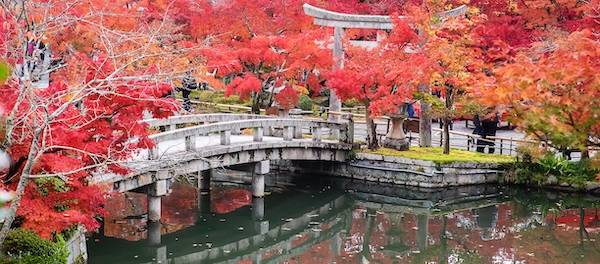The Four Seasons of Japan
From white to pink to green to red and yellow, the beauty of Japan changes in each of its four distinct seasons. As the country spans 3,000 km from the northeast Sea of Okhotsk to the southwest East China and Philippine Seas, the climate varies greatly. The northern island of Hokkaido has short, mild summers and long winters with heavy snowfalls, while the southern island of Okinawa is subtropical. Japan’s mainland experiences sharp differences from Siberian cold fronts on the western seacoast and warmer sea currents on the eastern Pacific coast.
Spring (March to May)
Spring may be the most beautiful time of year to visit Japan, with mild weather and trees in blossom, especially cherry trees. Cherry blossom times and viewings move from south to north. This is often followed by a rainy period that can come with strong winds. The busiest travel season is Golden Week, a series of national holidays at the end of April and in the first week of May. The days are warm, but the evenings are chilly.

What to pack:
• Sweaters and a jacket for the north
• Summer clothing for the south
• A rain resistant jacket and an umbrella are recommended. However, inexpensive umbrellas
are readily available at most convenience stores
• Pool and versatile exercise facilities
Summer (June to August)
Summer in Japan is hot and extremely humid, with temperatures in many places reaching 40°C. June is the rainy season for most of Japan, and the temperature temporarily drops. However, the mountains and the northern island of Hokkaido are an exception for both. From July to August, summer festivals are held across Japan, with people carrying a mikoshi (a portable shrine) on their shoulders to parade through town. Evening fireworks on the beaches and riverbanks are breathtaking.

What to pack:
• Light, comfortable, easy-to-dry clothing
• Handkerchiefs are highly recommended because of the humidity
Autumn (September to November)
While June is the rainy season, September has the highest risk of typhoons. Although the weather is unpredictable, it is generally mild. October is a recommended time for travelling, as it is less humid than in summer, but still comfortably warm. Beautiful autumn leaves can be seen on trees beginning in northern Japan and higher altitudes before sweeping to the rest of Japan in November. Kyoto, Nara, and Nikko are popular destinations for viewing the gorgeous changing leaves.

What to pack:
• Layered clothing
• Sweaters or a jacket for the north or the hills
Winter (December to February)
Although Tokyo gets very little or no snow, the rest of the mainland gets some snow, with average temperatures between 1°C and 5°C. Expect heavy snow on the northern island of Hokkaido, in the Japan Alps, and on much of the Japan Sea coast. Despite the snow, the weather is usually not damp and is pleasantly crisp.

What to pack:
• Warm clothing and a winter coat or ski jacket
• Footwear that is suitable for the snow if you are travelling in the north
The complete article can be found in Issue #280 of the Tokyo Journal.


